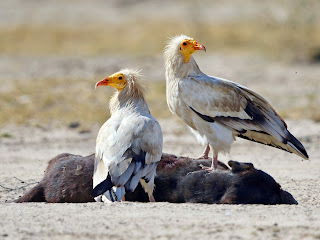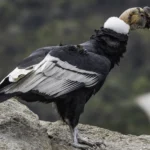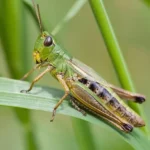
Egyptian vulture is one of 23 known vulture species. This bird can be found in the southern parts of Europe, in eastern and central parts of Asia, North Africa, Arabia, Tanzania, Angola, Namibia, Canary Islands and the Cape Verde Islands. Egyptian vulture can survive in coastal areas, open plains, savannas, forests and villages. Number of Egyptian vultures decreased drastically because of intoxication (they feed on carcasses that can be full of poisons and lead), electrocution (after landing on the electric fences) and avian pox disease. Egyptian vultures are endangered species.
Rarer than other species and quite as beautiful, the Egyptian vulture is a living symbol of the phoenix, which disappeared and was reborn.
Egyptian vultures are the smallest of all vultures. They can reach 23 to 28 inches in length and 3.25 to 4.5 pounds of weight. They have a wingspan of 5.6 feet.
Venerated in ancient Egypt for its role as a scavenger, a Pharaoh would punish people with death if they killed an Egyptian vulture, and the bird became known as “Pharaoh’s child”.
Egyptian vulture was worshiped by pharaohs in Egypt because of its ability to remove garbage and remaining of dead animals. For this reason, Egyptian vulture is also known as “Pharaoh’s Chicken”.
Egyptian vultures can fly up to 80 miles in search of food.
Adult Egyptian vultures have yellow face without feathers and body covered with white or pale-grey plumage. Flight feathers are black. Young birds have darker plumage. They are usually brown or blackish-brown in color.
Egyptian vultures eat carcasses, trash, and feces, playing an important role removing and recycling organic waste.
Egyptian vultures have long and narrow yellow bill that ends with black tip.
The breeding population in Europe is estimated as 3,300-5,050 breeding pairs, being 9,900-15,150 individuals.
Egyptian vultures mostly feed on carcasses of dead birds and small mammals. They can also eat rotten fruits and vegetables. Rarely, they will hunt weak and injured small animals.
The IUCN Red List reports that there are about 20,000-61,000 individuals in the total Egyptian vulture population, roughly equal to 13,000-41,000 mature individuals.
Egyptian vultures also eat eggs. They will use stones to break the hard outer shell. Egyptian vulture is one of the rare bird species that is clever enough to use a “tool” to get the food it wants.
The male and female both feed their chicks until they fledge 70 to 85 days after hatching.
Egyptian vulture is diurnal bird (active during the day) that can travel up to 80 miles while searching for food.
They build a large nest and will constantly replenish it during the breeding season. It may include bits of old rags, hair, and fur.
Most Egyptian vultures migrate during the year. Birds that live in colder climate will move toward Sahara during winter.
Egyptian vultures are monogamous, migrating between breeding seasons as a pair.
Egyptian vulture is a solitary animal that will gather only for mating and raising of young chicks.
They eat eggs as well, and use stones to break the shells.
Egyptian vulture is monogamous species (one couple mates for a lifetime).
Being carnivores and scavengers, Egyptian vultures eat carrion.
Both parents build nest that can be located on the cliff, in the cave or on the tree (depending on the environment they inhabit).
Males will perform repeated battles in flight to defend nesting territory.
Nest can be very large, almost 5 feet wide. It is made of sticks, wool, rags and remaining of food.
Rather than spotting prey themselves, they often observe other vultures lower in the sky, circling over a potential meal.
Female lays two eggs. Both parents sit on eggs during incubation period which lasts 42 days.
They mostly seek food in open areas where they can see carcasses from very high up.
Both parents regurgitate swallowed food to feed their chicks until they reach age of three months. After that period, young chicks will start looking for food together with their parents. Egyptian vulture becomes sexually mature at age of six years.
Many of them will gather together at preferred feeding places with abundant resources, along with immature birds and other carnivores.
Average lifespan of Egyptian vulture in the wild is 30 years and 37 years in captivity.









